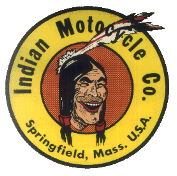No Mario, that isn't normal. Or maybe, depending on the amount. The Indian will mark its territory a little, especially if the vent tube is on the left side crankcase. Not so much if the vent is on the cam cover.
What (i suspect) is happening if it is occuring after a time (a night or longer) of stand still is that oil from the oil tank is leaking past the internals in the oil pump, and is collected in the cam compartment and in the crankcase. The cause for that can either be a too thin oil or a oil pump that is worn or pitted internally by rust.
One very risky remedy is to put a petcock on the oil line. If you just once forget to turn it on, the engine becomes ruined after a few miles. Another risk is that a air bubble is trapped in the oil line after a lengthy, say weeks, standstill and the pump can't feed oil then (air lock) with a catastrophic result again for the engine.
If the excessive oil purging occur after each or most starts, the reason is most probably over-oiling, the pump is set too rich. Check often the crankcase oil level, adjust at most by a 1/4 of a turn on the screw, first ride a couple of miles between checks, then as you get the hang of the oil consumption, you can check after further and further distances. It is tedious but has to be done. I personally think it is OK when a amount of oil escapes when I remove the level plug, up to almost one deciliter. When no oil runs out, I open the pump a bit, often by just 1/8th of a turn.
A too thin oil is easy to fix, use as thick oil as possible. Single or multigrade oils? That's a bit complicated. Multigrade oils are indexed at 2 temperatures, cold (test temperature is set at +40 deg.C) and warm (+100 deg.C) Single grade oils are indexed only at the cold temperature. My guess it is a bit cheaper to classify those oils.
So single grade isn't a sign that these type of oils are better or have a higher viscosity at high temperature than multi grade oils. A single 20 oil has the same viscosity as a 20W-50 oil when cold. A single 50 oil might have the same viscosity at 100 degC as the 20W-50 but not for certain!
The viscosity index doesn't mean that the oil is running through a hole at the same speed when cold as when warm, it is a bit confusing since the index is set with different funnel aperture (or test rigs) when cold and hot. The oiltest bodys are doing this by heritage since way back and also to make we, the end users confused.
Then (SAE) is testing the high shear rate at 150 deg.C, but that important data that would indicate some sort of quality difference isn't shown on the end-user container anywhere. That's up to the oil companies to blow dust in our eyes. According to (SAE) 40,50 and 60 grade oils must comply to the same high shear rate viscosity at 150 deg.C.
Our engines is at all times fed cold oil into the oil pump. Only true fact is that 50 single grade oil is thicker when cold, than for example 20W-50.
Next cause is if the oil pump is worn or pitted. That is a real problem since there seems no one in the world is restoring the internals or making a reproduction of the pump. The fitting between the bore and barrel is only a maybe half of a thousand parts of an inch, and that close fitting together with the high viscosity of the oil is the only thing that prevents oil to leak past. With wear the cylinder becomes a bit oval and oil starts to leak.
Jeff T. Butz is making good work restoring the outside, nipple repairs, new (internal) pump springs, screws and more.


